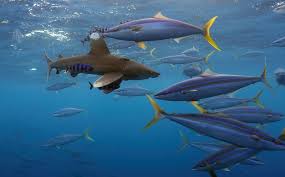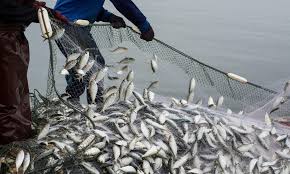(i) Foreign exchange earning either through exports or import substitution of fish and fishery products
(ii) A healthy population with an important source of animal protein rich in essential amino acids
(iii) Gainful employment to a segment of the population particularly those in coastal rural communities
(iv) Promotes the development and growth of ancillary industries e.g. ship building, net making, cold room business in the fish preservation industry.
Management of Fishery Resources
Management of fish resources is designed therefore to exploit them at optimal level on a sustained basis to achieve economy of operation at minimum cost. The following are measure taken by the country in managing her marine resources which at the same time check all abnormal fishing activities going on around the water bodies of economic value.
• Limitation of the size of vessels
Limit is placed on the size of vessels allowed to fish in inshore waters, 0-50m for instance only vessels of 100 GRT are allowed to fish in the inshore waters.
• Establishment of minimum cod-end mesh size
Nigeria for instance has adopted a cod-end mesh size of not less than 76mm when trawling for fish and 44mm when trawling for shrimps. This is to allow immature fish to escape the net, grow and mature to breed.
Read Also: Concepts of Wildlife and Wildlife Management
• Licensing of fishing vessels
Vessels must be licensed and must fly the national flag before they can fish in territorial waters. This measure is targeted at controlling fishing efforts and generates revenue.
• Restriction of fishing to certain areas of the coast
Imposition of restriction to designated fishing area is to protect some fisheries. In Nigeria, trawling for shrimps is prohibited West of the Niger delta to ensure that the small mesh size of shrimp trawls do not destroy immature croakers which constitute the backbone of the inshore industrial fishery. Valuable fish stocks are most abundant to the east of it.
• Prohibition of trawlers from operating within certain limits of the shore
This is to minimise the conflict between artisanal coastal fishermen and semi-industrial trawlers. Such trawlers often violate this limit and destroy nets of artisanal fishermen. In Nigeria, trawlers shall not fish within the first 2 nautical miles of the coast. However, there is need to extend this limit to 5 nautical miles of the coast.
• Closed season
Breeding and nursery grounds of important fishes and shell fish may be closed to fishing at breeding seasons to protect juvenile fish in nursery grounds e.g. The Bonga fish and shrimps. It is very common for the artisanal fishermen to catch the young of bonga fish and the shrimps at
their nursery grounds with nets of small mesh sizes less than 25mm.
Table 1: Important Marine and Brackish Water Fish Species

| Order | Family | Species | |
| 1 | Rajiformes | Dasyatidae | Dasyatis centroura, D.margarita, D. pastinaca, |
| 2 | Lepidosireniformes | Protopteridae | Protopterus annectens |
| 3 | Characiformes | Hepsetidae,Characidae , Distichodontidae, Distichodae, Citharinidae, Icthyboridae | Citharinus citharus, Distichodus niloticus |
| 4 | Clupeiformes | Clupeidae | Ethmalosa bidorsalis, E. fimbricata, Ilisha africana |
| 5 | Cypriniformes | Cyprinidae (Carps & Barbs) | Labeo senegalensis L. cubie, Barbus occidentalis |
| 6 | Elopiformes | Elopidae | Elops lacerta |
| 7 | Momyriformes | Mormyridae, Gymnarchidae | Gymnarchus niloticus, Mormyrops rume, M. deliciosus |
| 8 | Ophiocephaliformes | Channidae | Channus obscura, Parachanna africana |
| 9 | Osteoglossiformes | Osteoglossidae, Notopteridae Pantodontidae | Notopterus afer, N. nigri |
| 10 | Perciformes | Centropomidae, Carangidae, Lutjanidae, Eleotridae, Anabantidae, Cichlidae, Mugilidae, Gobiidae, Nandidae, Monodactylidae | Lutjanus agennes, Eleotris kribensis, E.nanus, E. vattata, Oreochromis niloticus |
| 11 | Polyperiformes | Polypteridae | Polypterus ansongei P. senegalus, P. endlicheri |
| 12 | Siluriformes | Ariidae, Bagridae, Clariidae, Malapterinidae, Mochokidae, Schilbeidae | Clarias anguillaris, C..gariepinus, Heterobranchus longifilis, Chrysichthys nigrodigitatus, C. walkeri C. auratus, Arius gigas, Synodontis sorex, S. ocellifer, S. filamentosus |
Table 2: Important Commercial Shell Fish Species
| S/N | Family | Common Name | Scientific Name |
| 1 | Penaeidae | Guinea shrimp Deep water rose shrimp Caramote prawn | Parapenaeopsis atlantica Parapenaens longirostris Penaeus kerathurus |
| 2 | Geryonidae | West African geryon | Geryon maritae, G. quinquedens |
| 3 | Sepiidae | Common cuttle fish | Sepia officinalis |
| 4 | Loliginidae | European squid | Loligo vulgaris |
| 5 | Cardiidae | Costate cockle Gaping cockle Mangrove oyster | Cardium costatum Cardium ringens Crassotrea gasar |
| 6 | Octopodidae | Common octopus | Octopus vulgaris |
| 7 | Palaemonidae | Congo river prawn Giant fresh water prawn African river prawn Brackish water prawn Creek shrimp Estuarine prawn | Macrobrachium dux M. rosenbergii M. vollenhovenii M. macrobrachion Palaemonetes atlantica Nematopalaemon hastatus |
| 8 | Palinuridae | Spiny lobsters | Panulirus regius |
| 9 | Osteridae | Flat oyster | Ostrea edulis |
Read Also: Economic Importance of Fishes and Fish Farming Business
Read Also: Metabolic Wastes Complete Management Guide

